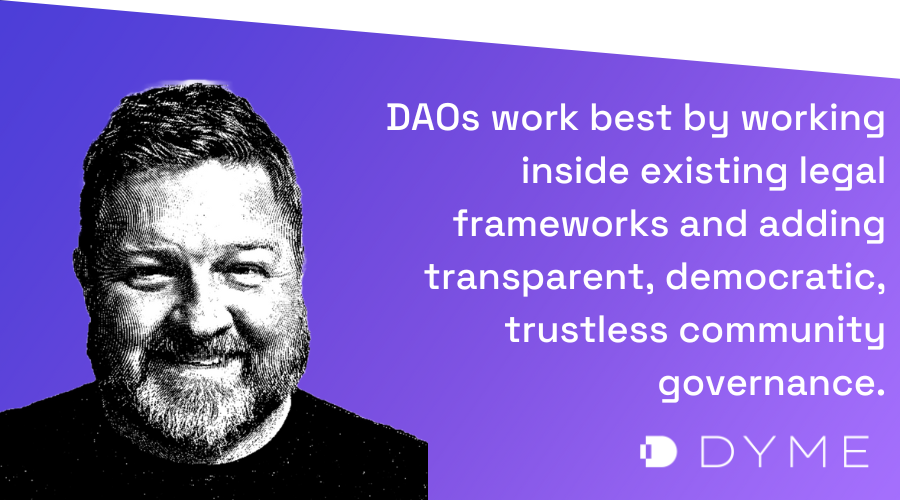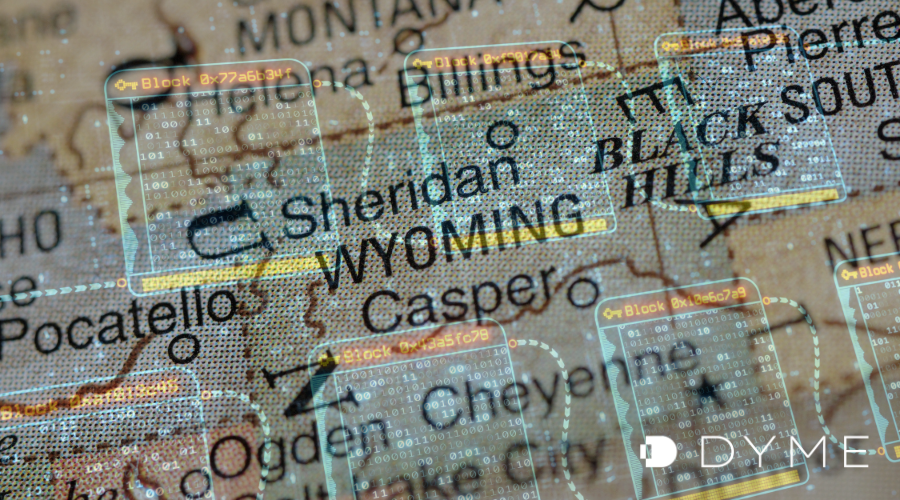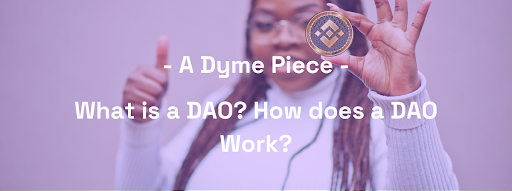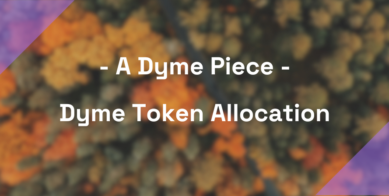The phrase decentralized autonomous organization is commonly abbreviated as DAO. A DAO is a collectively-owned, blockchain-governed organization working towards a shared mission.

Before moving on, it’s important to distinguish a DAO from The DAO, one of the first such organizations ever created. The DAO was a project founded in 2016 that ultimately failed and led to a dramatic schism in the Ethereum blockchain.
DAOs allow us to work with other DAO members around the globe without trusting centralized leadership to manage the funds or operations. There should be no CEO who can spend funds on a whim or CFO who can manipulate the books. Typically, blockchain-based rules memorialized as smart contracts in the code define how the DAO works and how funds are spent.
Dyme is a DAO. Dyme moves past just memorializing the DAO rules in smart contracts and goes further by aligning the legal formation and the legal documents memorializing oversight and management with the DAO’s code. We believe that this alignment of smart contract and traditional central authority legal status is novel in the community.
What does DAO mean?
You won’t find the terms “decentralized autonomous organization” or “DAO” in securities law. This means that any definition of DAO as a legal structure needs to combine blockchain governance proposals with the legal structures of a traditional organization.
One exception to this is Wyoming, which on July 1, 2021 became the first U.S. state to recognize decentralized autonomous organizations as legal entities. Wyoming is known to be a friendly jurisdiction for digital assets and blockchain technology.
Smart contracts meet traditional organizations

In general terms, DAOs are member-managed communities without centralized leadership. A DAO is typically run in a decentralized manner. Community members are usually token holders in the DAO native token. DAO members can freely submit proposals regarding governance. They also participate in the outcome of the proposals, using their voting power to effectively participate in oversight and management.
This meaning explicitly avoids the topic of ownership and the term member-owned communities. Dyme believes a DAO can be fully decentralized, fully autonomous, and conform with securities laws by using a properly implemented legal structure aligned with well-written smart contracts and engaged community members. However, this does not convey ownership in the context of DAO tokens or other collective ownership models.
DAO as algocracy
The code held in a smart contract or set of smart contracts can provide algorithmic management of a DAO. This is the basis for the belief that a DAO exemplifies an algocracy.
The terms “algorithmic governance” and “government by algorithm” have been used in academic literature since 2013, predating the work of the Ethereum community, which nurtured – for a short time – the first Ethereum blockchain DAO.
First DAO: Part venture capital fund, part decentralized exchange, all Ethereum network disaster
The first of the decentralized autonomous organizations was part of the Ethereum community. The DAO was launched in April 2016 via a token sale and represented one of the world’s largest crowdfunding campaigns. It was defunct within six months.
In those six months, five major things happened:
- The DAO launched in April 2016 and sold securities to token holders using the Ethereum blockchain in the crowdfunding effort mentioned earlier. Among the stated goals was a goal was to raise funds for a new type of venture fund.
- Days after the token sale for The DAO ended, community members identified flaws in the publicly viewable smart contract language.
- Within a month, flaws in their code and flaws in their ability to update their code exposed The DAO to a hack that saw 1/3 of their value wiped out.
- There was quite a brouhaha. Some community members argued for effectively unwinding the smart contract results and returning the native token ETH to the original crypto wallets. Others argued that The DAO had to live with the outcome to remain ethically valid.
- A hard fork of the Ethereum blockchain took place. The forked blockchain is Ethereum; the unforked blockchain is Ethereum Classic.
A year later, the U.S. Securities and Exchange Commission published a report about The DAO. The United States Securities and Exchange Commission report concluded that The DAO sold securities and possibly violated U.S. federal securities laws.
So many other DAOs since then
Globally, many countries have become friendly to forming a decentralized autonomous organization or supporting companies using blockchain technology. Switzerland, Malta, Singapore, Bermuda, Cayman Islands, British Virgin Islands, and Dubai have all advanced different forms of legislation to help a DAO work more effectively.
Similarly, a diverse set of DAOs have been established since The DAO incident of 2016. The crypto community and government agencies globally have worked to enable a working DAO structure and organization. We look at some recent projects later in this article.
How DAOs operate: Location, DAO tokens, governance tokens, and a splash of central authority
Location
Dyme believes a DAO can be completely decentralized, fully autonomous, and conform with securities laws by using a properly implemented legal structure aligned with well-written smart contracts and engaged community members. A key part of that proper implementation is location.
Dyme Foundation was formed in September 2022 as an Exempted Foundation Company under the laws of the Cayman Islands. The Foundation subsequently formed an operating company and instituted corporate documents to conform to the smart contract logic built into Dyme’s governance module.
DAO tokens
Cryptocurrencies have become increasingly popular, but many people don’t understand the details of how they work. With so much hype around cryptocurrencies and blockchain technology, it can be difficult to know what a DAO token is and how it works.
A DAO (Decentralized Autonomous Organization) token is a type of crypto asset that gives holders rights within the organization’s decision-making structure. DAO tokens are used to incentivize users to participate in decision-making processes related to developing and maintaining dApps or other projects on a blockchain network. The tokens also allow users to access certain features or services within dApps and receive rewards for participating in activities such as staking or mining. By owning these tokens, individuals can influence decisions made by dApp developers or project teams or can fully manage the activities and direction of the DAO as part of a decentralized, democratic community.
Governance tokens: Voting power to the community, sometimes
DAOs are complex systems that involve various stakeholders and decision-making processes, making it difficult to know what a governance token is and how it works. And as you’ve read, sometimes the actions of a DAO don’t match the stated goals of the DAO.
A DAO token is used as a means to participate in an organization’s decision-making structure. Often this participation is oligarchic, where each token has a vote. Rarely it is democratic, where each wallet has a vote. By owning these tokens, individuals can determine the organization’s direction.
This is the decentralized part of a DAO. Obviously, a DAO with a CEO makes no sense since the organization’s control is in the community’s hands. Overly centralized ownership can also adversely impact governance proposals, particularly if votes are tabulated according to ownership. This inherently oligarchic approach to oversight and management is one reason Dyme exists: Dyme is democratic.
The reality of central authority in a DAO
Every DAO stands for transparent, decentralized management. So why do so many fall down? Central authority.
It isn’t the only reason, but it’s a big reason that DAOs fail.
Money always wants control. A single entity often seeks absolute control. This is the central problem with most DAOs, in that the organization’s best interest may not align with the financial interest of the organization with a wallet full of DAO tokens.
And in each case where it happens, the DAO is structured to let it happen. It’s sort of a hard fork in the design of the DAO, violating portions of the central tenets of DAOs.
The benefit of thoughtful legal structure for the DAO model
A DAO works best by working inside existing legal frameworks and adding transparent, democratic, trustless community governance. It should neither avoid regulation nor empower central control.
A thoughtful structure allows this to happen. I believe Dyme has a DAO structure that is fully decentralized, autonomous, and conforms with securities laws by using a properly implemented legal status aligned with well-written smart contracts and engaged members.
Disadvantages of DAOs
In theory, a DAO has few disadvantages. In practice, it’s a complex thing to get right. As a working entity, a DAO requires active, involved voices and a way to project those voices both inside and outside the DAO membership.
It’s also a challenge to let go of control. As I wrote earlier, money wants control…but it’s not the only group that wants control. Trusting in the community to find a successful path for a developing organization means aligning incentives to reward positive behavior.
Examples of Crypto DAO Projects
Compound (COMP) – Popular Crypto Lending DAO Trading at a Discount
Compound is a decentralized, blockchain-based protocol that allows you to lend and borrow crypto directly. That makes it sort of a decentralized Celsius. This has been good for Compound since the transparent nature of the smart contracts means token holders see how their company is using their staked crypto to generate returns.
DeFi Coin (DEFC) – New DAO Project with Passive Income Potential
Are algorithmic tokens still a thing? DeFi Coin believes they are. This project is built on the Binance smart chain. The DeFi Coin DAO management seems centered around a management team, based on a reading of their June 2022 white paper.
Calvaria – P2E and F2P GameFi Project with DAO Governance
The GameFi project Calvaria blends financial transactions with open-source code. That makes their native token a play-to-earn token. The voting mechanism and governance are not well defined currently, but they’re an early project which intends to evolve into a DAO.
ApeCoin (APE) – Best ‘Meme Coin’ DAO

The first thing to know about ApeCoin is it doesn’t seem connected to the Bored Ape Yacht Club. Or anything to do with Yuga Labs. At all. This is sad for many reasons, but one reason is the lack of tiki themes in APE.
Still, APE does have an interesting governance model, and the way they say they’ll manage treasury funds is good. Their model for voting rights is to round down fractional ownership, which still seems a very oligarchical way to manage voting power for a DAO.
Illuvium (ILV) – Upcoming NFT Gaming Project with DAO Governance
Link to their DAO site: https://illuvium.io/
A cool thing to note is that the Illuvium DAO uses quadratic voting, which is intended to “reduce plutocracy.” The math behind this voting mechanism is not defined, however.
Note that the links to the remaining three projects are provided without comment on their DAO structure or any assessment of whether their DAO held tokens at the time of writing.
Dash (DASH) – Innovative ‘Privacy Coin’ Set for a Rebound
Curve (CRV) – Ethereum-based DeFi Protocol for Stablecoins
Tamadoge – Upcoming Meme Token DAO project
Closing: Understanding Decentralized Autonomous Organizations (DAOs)
“All DAOs are not created equal. Some wallets are more equal than others.”
With apologies for hacking up an elegant quote, the key to understanding a DAO is having confidence in the alignment between what it says it’ll do and how it operates. Look for a DAO that solves a problem you understand. And look for a group, even a small group, of people dedicated to helping one another.




127 thoughts on “What is a decentralized autonomous organization, and how does a DAO work?”
Comments are closed.